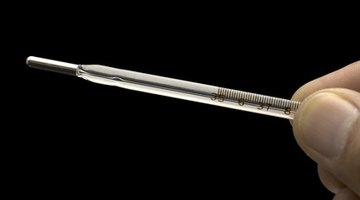Thermometers are designed to measure temperatures within specific ranges for various purposes. For the retail consumer, the most common applications are for cooking, health monitoring and inside/outdoor temperature.
Historically, mercury thermometers have been used for nearly all temperature measurements because of their accuracy and low cost. However, their use is increasingly being restricted to industrial and scientific applications, as safety and environmental issues are demanding stricter laws on the disposal of products containing mercury.
Identification
Thermometers are typically constructed of a hollow glass tube with a reservoir at one end to hold a liquid, which is sensitive to temperature fluctuations within a specific range. Mercury in its liquid form has traditionally been used because of its fluid properties of separation and adherence through temperature extremes. It is identified by its familiar silver metallic colour. Thermometers containing a blue or red colour liquid are most often utilising an organic fluid, usually alcohol-based. Visual indicators are marked in degrees Fahrenheit, Centigrade or both.
- Thermometers are typically constructed of a hollow glass tube with a reservoir at one end to hold a liquid, which is sensitive to temperature fluctuations within a specific range.
- Thermometers containing a blue or red colour liquid are most often utilising an organic fluid, usually alcohol-based.
Mechanisms of Action

The coefficient of thermal expansion describes how the size of an object changes with a change in temperature. When something changes temperature, it shrinks or expands in all three dimensions. In a mercury- or alcohol-filled thermometer, it is the change in fluid volume that is important. Specifically, it is calibrated and measured at the volume per degree change in temperature at a constant pressure. Expansion or contraction of the glass tube and reservoir enclosing the liquid within is negligible, since liquids generally have a substantially larger coefficient of thermal expansion than solids. The manufacturer calibrates and marks the thermometer so the top of the fluid column (meniscus) indicates an accurate temperature reading.
- The coefficient of thermal expansion describes how the size of an object changes with a change in temperature.
- In a mercury- or alcohol-filled thermometer, it is the change in fluid volume that is important.
Advantages & Disadvantages of Mercury Thermometers
Mercury thermometers are inexpensive, durable and accurate. However, they present many safety and environmental hazards. Metallic mercury in its liquid state is relatively harmless when confined. However, in a gaseous state, as organomercuric compounds or as inorganic salts, it becomes a deadly toxin. Mercury is especially harmful to foetuses, infants and children.
The metallic mercury in thermometers, if introduced into the environment in a non-controlled manner, can eventually enter the water ecosystem, where microorganisms break it down to methylmercury components. Fish and sea animals at the top of the food chain of the ocean, lakes and streams consume these compounds in their diets, where they tend to accumulate in their body tissues. According to Medicinenet.com, all birds and mammals are threatened by death, reduced reproduction, slower growth, delayed development and abnormal behaviour as a result of a diet high in contaminated seafood.
- Mercury thermometers are inexpensive, durable and accurate.
- The metallic mercury in thermometers, if introduced into the environment in a non-controlled manner, can eventually enter the water ecosystem, where microorganisms break it down to methylmercury components.
Advantages & Disadvantages of Alcohol Thermometers

Alcohol thermometers are also inexpensive and durable. They are typically not as accurate as mercury thermometers because of the alcohol’s susceptibility to evaporation, polymerisation potential and capillary separation. Their primary advantage is safety to humans and the environment.
The major disadvantage of alcohol thermometers is the limited use at very high temperatures as in cooking, because of the low boiling point of the thermometer’s liquid contents. Thermister-based or “metal thermometers” are recommended in these applications, which do not utilise any liquid for temperature measurement.
- Alcohol thermometers are also inexpensive and durable.
- The major disadvantage of alcohol thermometers is the limited use at very high temperatures as in cooking, because of the low boiling point of the thermometer’s liquid contents.
Safety Considerations
Broken alcohol thermometers can be disposed of in an ordinary fashion, being careful of any broken glass.
Mercury thermometers should never be accessible by infants or children.
A broken mercury thermometer should be handled as an emergency situation requiring immediate attention. The U.S. Environmental Protection Agency has excellent instructions on how to handle a broken mercury thermometer situation available online.
- Broken alcohol thermometers can be disposed of in an ordinary fashion, being careful of any broken glass.
- A broken mercury thermometer should be handled as an emergency situation requiring immediate attention.
